KIA Niro 2017 Owners Manual

Hybrid System Overview
HEV (HYBRID ELECTRIC VEHICLE) SYSTEM / H2 NIRO HYBRID ENERGY FLOW / H3 STARTING THE HYBRID VEHICLE / H6 THE COMPONENTS OF HYBRID VEHICLE / H8
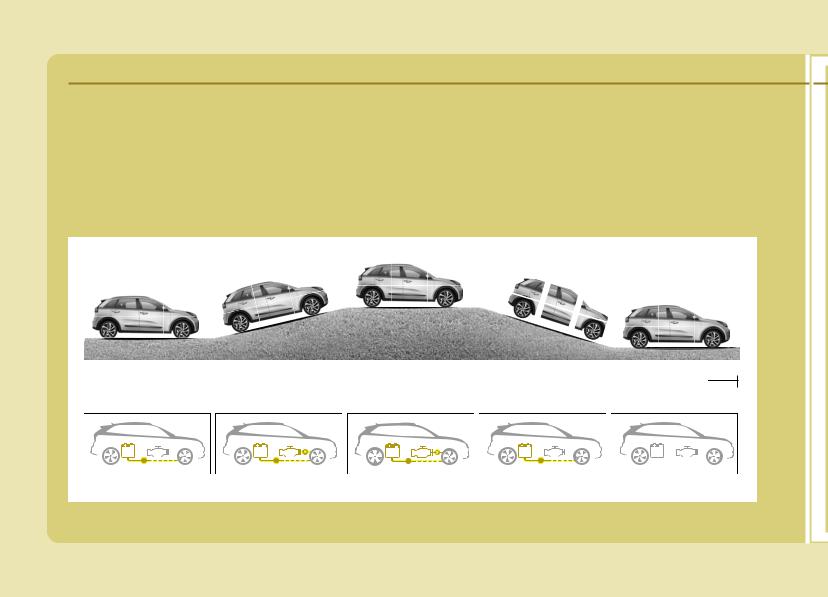
 HEV (HYBRID ELECTRIC VEHICLE) SYSTEM
HEV (HYBRID ELECTRIC VEHICLE) SYSTEM
The Kia Hybrid Electric Vehicle (HEV) uses both the gasoline engine and the electric motor for power. The electric motor is run by a 240V high-voltage HEV battery.
Depending on the driving conditions, the HEV computer selectively operates between the engine and the electric motor or even both at the same time.
Fuel efficiency increases when the engine is at idle, or when the vehicle is driven by the electric motor with the HEV battery.
The HEV battery charge must be maintained for the times when the engine acts as a generator, such as when stopped at idle. Charging also occurs when decelerating or by regenerative braking.
 Electric motor
Electric motor 
 Electric motor + Engine
Electric motor + Engine 
 Engine
Engine 
 Charging
Charging 
 Engine OFF
Engine OFF
|
Start up / Low speed cruise |
|
|
Acceleration |
|
|
High speed cruise |
|
|
Deceleration |
|
|
Stop |
||||||||||
|
|
|
|
|
|
|
|
|
|
|
|
|
|
|
|
|
|
|
|
|
|
|
|
|
|
|
|
|
|
|
|
|
|
|
|
|
|
|
|
|
|
|
|
|
6 |
|
|
|
|
|
|
|
|
|
|
|
|
|
|
|
|
|
|
|
|
|
|
|
|
|
|
|
|
|
|
|
|
|
|
|
|
|
|
|
|
|
|
|
|
|
|
|
|
|
|
|
|
|
|
|
|
|
|
|
|
|
|
|
|
|
|
|
|
|
|
|
|
|
|
ODE056001
H2 http://carownersmanuals2.com
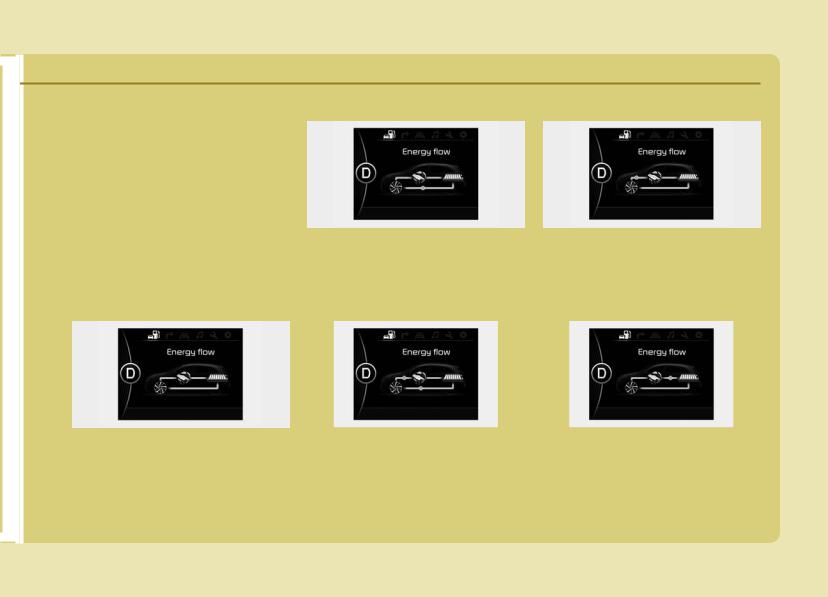
 NIRO HYBRID ENERGY FLOW
NIRO HYBRID ENERGY FLOW
Kia hybrid system notifies the drivers EV Propulsion |
Engine Only Propulsion |
of energy flow in various operating |
|
modes. The operating condition of |
|
the vehicle can be shown in the fol- |
|
lowing eleven modes. |
|
ODE046121L |
ODE046123L |
Electric power is used to move the vehicle. (Battery Wheel)
Engine power is used to move the vehicle. (Engine Wheel)
Vehicle Stop |
Power Assist |
Engine Generation |
ODE046120L
The mode means the vehicle at stop. (There is no energy flow.)
ODE046122L |
|
ODE046124L |
Electric and Engine power are used |
Vehicle is stopped with the Engine |
|
to move the vehicle. |
charging the hybrid battery. |
|
(Battery & Engine Wheel) |
(Engine Battery) |
|
H3
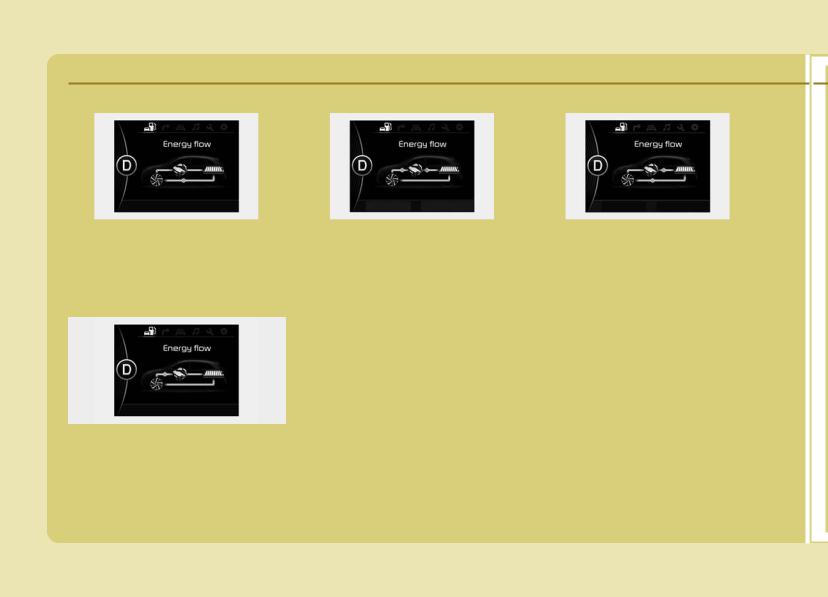
Regeneration |
Power Reserve |
Engine Generation/Regeneration |
ODE046121L |
|
ODE046127L |
|
ODE046128L |
Hybrid battery is being charged by regenerative braking.
(Wheel Battery)
Engine Brake
Engine is both driving the vehicle and charging the hybrid battery.
(Engine Wheel & Battery)
The engine and regenerative braking system charge the hybrid battery driving deceleration.
(Engine & Wheel Battery)
ODE046126L
The vehicle is being slowed by engine compression.
(Wheel Engine)
H4 http://carownersmanuals2.com
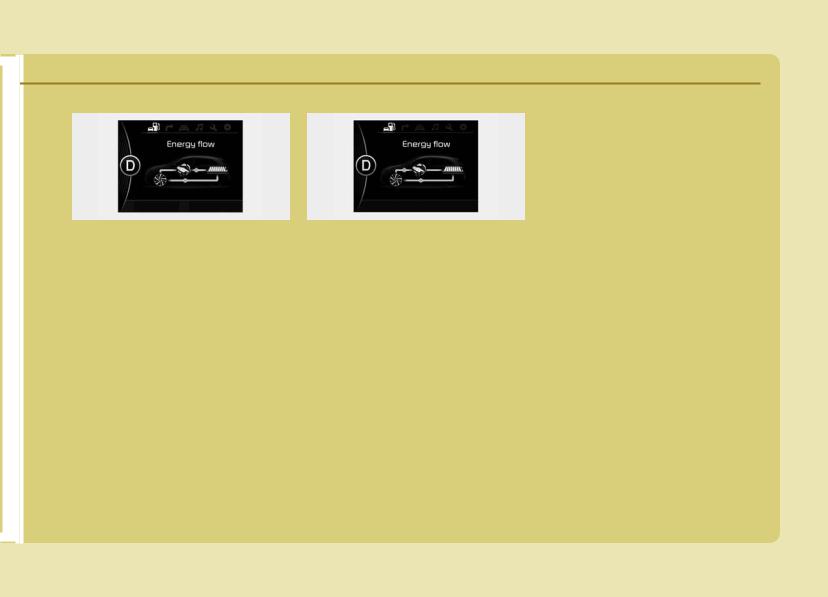
Engine Generation/Motor Drive |
Engine Brake/Regeneration |
ODE046128L
The vehicle is being slowed by engine compression and regenerative braking. The hybrid battery is being charged by regenerative braking.
(Engine Battery Wheel)
ODE046122L
The engine compression can be used to slow the vehicle. The regenerative braking system can be used to charge the hybrid system.
(Wheel Engine & Battery)
H5

 STARTING THE HYBRID VEHICLE (SMART KEY)
STARTING THE HYBRID VEHICLE (SMART KEY)
Starting the Hybrid System
1.Carry the smart key into the vehicle.
2.Make sure the parking brake is firmly applied.
3.Place the shift lever in the P(Park) position.
In N (neutral) position, you can not start the vehicle.
4.Depress the brake pedal.
5.Press the engine start/stop button.
6.The engine should be started without pressing the accelerator. In extremely cold weather or after the vehicle has not been operated for several days, let the engine warm up without depressing the accelerator.
•Even if the smart key is in the vehicle, if it is far away from you, the engine may not start.
•When the engine start/stop button is in the ACC or ON position, if any door is open, the system checks for the smart key. If the smart key is not in the vehicle, the warning, "Key is not in vehicle" will come on, and if all doors are closed, the chime will also sound for about 5 seconds. The indicator will turn off while the vehicle is moving. Keep the smart key in the vehicle when using the ACC position or if the vehicle engine is on.
If the starting procedure is followed, the "  " symbol on the instrument cluster will turn on. For more details, Please check chapter 6.
" symbol on the instrument cluster will turn on. For more details, Please check chapter 6.
H6 http://carownersmanuals2.com

ECONOMICAL and SAFE OPERATION of Hybrid system
•Drive smoothly. Accelerate at a moderate rate and maintain a steady cruising speed. Don't make "jack-rabbit" starts. Don't race between stoplights.
•Avoid heavy traffic whenever possible. Always maintain a safe distance from other vehicles so you can avoid unnecessary braking. This also reduces brake wear.
•The regenerative brake generates energy when the vehicle decelerates.
•When the hybrid battery power is low, the hybrid system automatically recharges the hybrid battery.
•When the engine runs in "N" position, the hybrid system cannot generate electricity. The hybrid battery cannot recharge in "N" position. Please refer to chapter 7.
NOTICE
When the hybrid system is in ready mode, the engine will automatically start and stop as needed.
The "  " symbol will illuminate in the cluster when the system is operational.
" symbol will illuminate in the cluster when the system is operational.
CAUTION - Extended cranking
Do not crank the engine for a prolonged period of time without the engine starting. This could result in damage to the HEV battery and becoming totally discharged.
H7
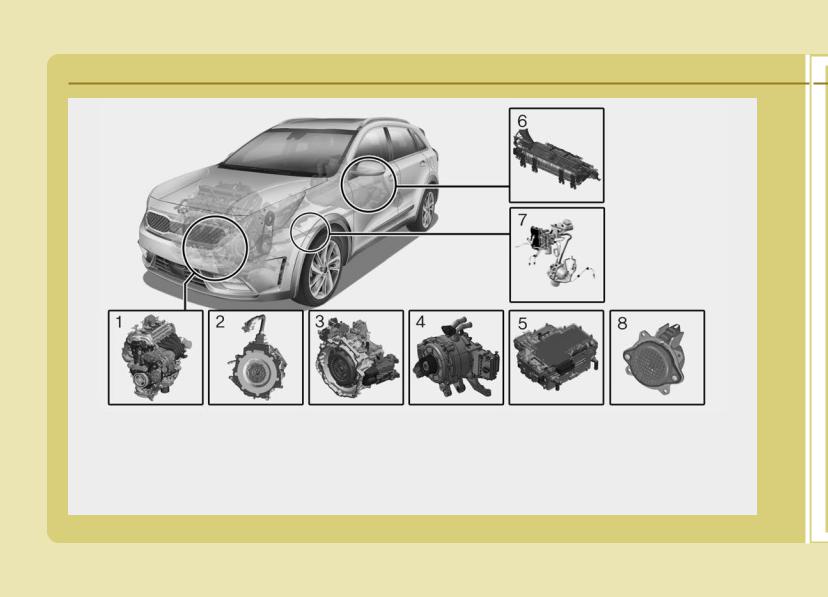
 THE COMPONENTS OF HYBRID VEHICLE
THE COMPONENTS OF HYBRID VEHICLE
1. Engine : 1.6L |
5. HPCU (Hybrid Power Control Unit) |
2. Motor : 32kW |
6. High voltage battery system |
3. Transmission : 6DCT |
7. Generative brake system |
4. Hybrid starter generator (HSG) |
8. Virtual Engine Sound System (VESS) |
The actual shape may differ from the illustration. |
|
ODEQ016001L
H8 http://carownersmanuals2.com
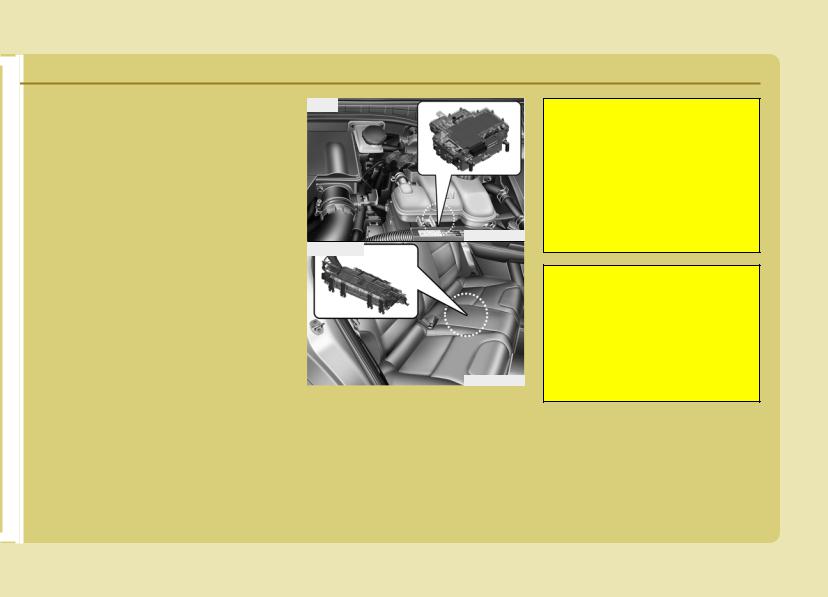
The Hybrid battery uses high voltage top operate the electric motor and other components and other components. High voltage is dangerous if touched.
Your vehicle is equipped with orange colored insulation and covers over the high voltage components to protect people from electric shock. High voltage warning labels are attached to some system components as additional warnings. Your vehicle is recommended to be serviced by an authorized Kia dealer.
HPCU
ODEQ016002
HEV Battery
ODEQ016003
WARNING - High voltage components
Never touch orange or high voltage labeled components including wires, cables, and connections. If the insulators or covers are damaged or removed, severe injury or death from electrocution may occur.
WARNING - Touching HPCU
When replacing the fuses in the engine compartment, never touch the HPCU. The HPCU carries high voltage. Touching the HPCU could result in electrocution, serious injury, or death.
H9

CAUTION - High Voltage Battery Damage
When loading your vehicle, be careful of transporting items in a manner that could damage the high voltage battery. Do not store items on top of the high voltage battery or overload the trunk area. Such actions may ultimately damage the high voltage battery unit.
CAUTION - Carrying Liquids in Trunk
Do not load large amounts of liquid in open containers in the vehicle. If spilled onto the HEV battery, the liquid may cause a short or further damage to the battery.
H10 http://carownersmanuals2.com

 THE COMPONENTS OF HYBRID VEHICLE (CONT.)
THE COMPONENTS OF HYBRID VEHICLE (CONT.)
Motor
ODEQ016004
WARNING - Battery electrolyte
As with all batteries, avoid fluid contact with the Hybrid battery. If the battery is damaged and if electrolyte comes in contact with your body, clothes or eyes, immediately flush with a large quantity of fresh water.
WARNING - After-market battery charger
Do not use an after-market battery charger to charge the Hybrid battery. Doing so may result in death or serious injury.
WARNING - High Waters
•Avoid high waters as this may result in your vehicle becoming saturated with water and could compromise the high voltage components.
•Do not touch the any of the high voltage components within your vehicle if your vehicle has been submerged in water equal to half of the vehicle height. Touching high voltage components once submerged in water could result in severe burns or electric shock that could result in death or serious injury.
H11

CAUTION - Cleaning Engine
When you clean the engine compartment, do not wash using water. Water may cause electric arcing to occur and damage electronic parts and components.
WARNING - Exposure to High Voltage
•High voltage in the hybrid battery system is very dangerous and can cause severe burns and electric shock. This may result in serious injury or death.
•For your safety, never touch, replace, dismantle or remove any portion of the hybrid battery system including components, cables and connectors.
WARNING - Use of Water or Liquids
If water or liquids come into contact with the hybrid system components, and you are also in contact with the water, severe injury or death due to electrocution may occur.
WARNING - Hot Components
When the hybrid battery system operates, the HEV battery system can be hot. Heat burns may result from touching even insulated components of the HEV system.
CAUTION - Prolonged parking
Prolonged parking might cause battery discharge and operation failure due to natural discharge. Driving the vehicle approximately once every 2 months, more than 15 km is recommended. The battery will be charged automatically when driving the vehicle.
H12 http://carownersmanuals2.com
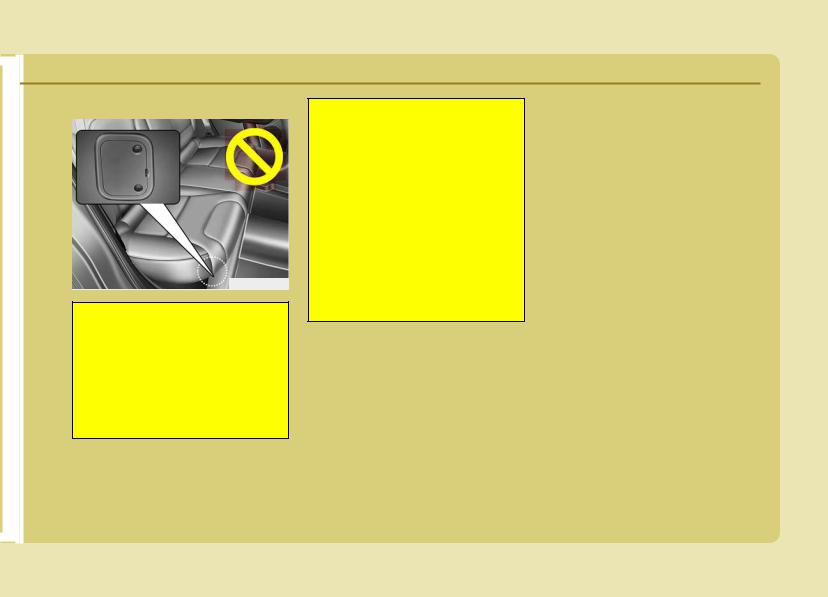
 THE COMPONENTS OF HYBRID VEHICLE (CONT.)
THE COMPONENTS OF HYBRID VEHICLE (CONT.)
Safety plug
ODEQ016006
WARNING - Safety plug
Never touch the safety plug. Safety plug is attached to high voltage hybrid battery system. Touching safety plug will result in death or serious injury. Service personnel should follow procedure in service manual.
WARNING
-Interference with electronic medical devices
Electromagnetic waves that are generated from the charger can impact medical electric devices such as an implantable cardiac pacemaker. When using such medical electric devices, ask your medical professional and the device manufacturer whether charging your electric vehicle will impact the operation of the medical electric devices.
Some Special Features of the
Hybrid Vehicle.
Hybrid vehicles sound different than gasoline engine vehicles. When the hybrid system operates, you may hear a sound from the hybrid battery system behind the rear seat. If you apply the accelerator pedal rapidly, you may hear a sound. When you apply the brake pedal, you may hear a sound from the regenerative brake system. When the hybrid system is turned off or on, you may hear a sound in the engine compartment. If you depress the brake pedal repeatedly when the hybrid system is turned on, you may hear a sound in the engine compartment. None of these sounds indicate a problem.
They are characteristics of hybrid vehicles.
When the hybrid system is turned on, the engine may run. This does not indicate a malfunction. If the "  " symbol is on, the hybrid system is operating. Even if the gasoline engine is off, you can operate the vehicle.
" symbol is on, the hybrid system is operating. Even if the gasoline engine is off, you can operate the vehicle.
H13

The HEV system may emit electromagnetic waves which can affect the performance of electronic devices appliances, such as laptop computers, which are not part of the vehicle design.
If you park the vehicle for a long time, the hybrid system will discharge. You need to drive the vehicle several times per month to maintain a charge.
When you start the hybrid system in the "P" transmission position, the "  " symbol is illuminated in the cluster. The driver can drive the vehicle even if the engine is not running.
" symbol is illuminated in the cluster. The driver can drive the vehicle even if the engine is not running.
WARNING - Turning off HEV system
When you leave the vehicle, turn off the hybrid system. If you leave the hybrid system on, you or another vehicle occupant could depress the accelerator pedal and, if it is in a position other than Park, the vehicle will begin accelerating. This may result in an accident causing serious injury or death.
Virtual Engine Sound System (VESS)
The Virtual Engine Sound System generates an engine sound for pedestrians to hear vehicle while at low speeds in EV mode.
H14 http://carownersmanuals2.com
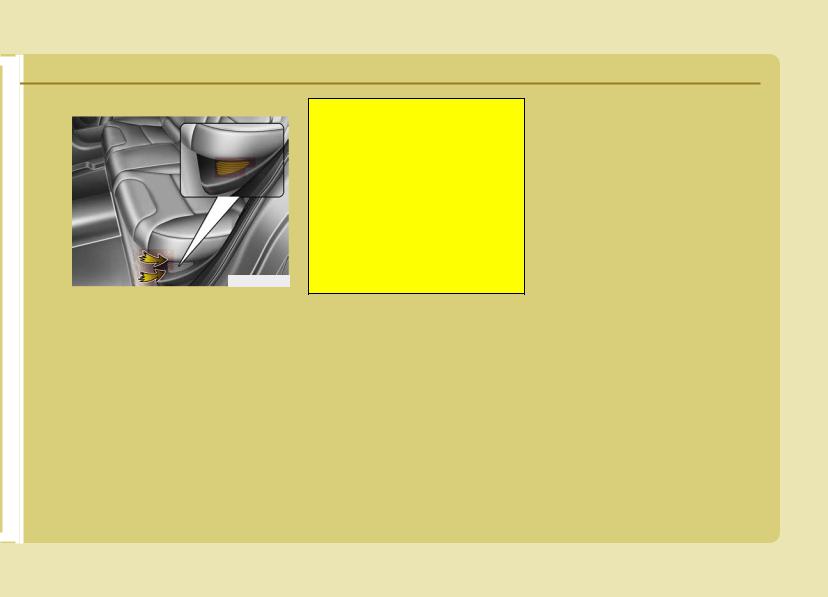
Hybrid battery air intake
ODEQ016007
The hybrid battery air intake is located on bottom the rear seats. The air intake cools down the hybrid battery. When the hybrid battery air intake is blocked, the hybrid battery may be overheated. Do not obstruct the air intake with any other objects.
WARNING - Air Intake
•Blocking the air intake behind the rear seats may damage the HEV battery.
•Do not allow any water into the air intake even when cleaning. If any water enters the air intake, the Hybrid battery may cause an electric shock which can cause serious injury or death due to electrocution.
H15

 THE COMPONENTS OF HYBRID VEHICLE (CONT.)
THE COMPONENTS OF HYBRID VEHICLE (CONT.)
If An Accident Occurs
•Avoid the engine compartment.
•Avoid any orange or high voltage wires, cables, or components.
•Assume that a high voltage component is exposed and move away from the vehicle as promptly as possible.
•Refer to Chapter 7 for towing information.
NOTICE
•If a small scale fire occurs, use a fire extinguisher (ABC, BC) that is meant for electrical fires.
If it is impossible to extinguish the fire in the early stage, remain a safe distance from the vehicle and immediately call your local fire emergency responders. Also, advise them that a hybrid vehicle is involved.
If the fire spreads to the high voltage battery, large amount of water is needed to put out the fire.
Using small amount of water or fire extinguishers not meant for electrical fires could cause serious injury or death from electrical shocks.
•If you need towing, refer to chapter 7.
If a vehicle accident occurs:
1.Stop the vehicle and shift the transmission into "P" position.
And then depress the parking brake.
2.Turn off the Hybrid system by pushing the Engine Start/Stop Button.
3.Evacuate to the safety place.
4.Call emergency services for help and let them know the vehicle is a Hybrid vehicle.
H16 http://carownersmanuals2.com

If an immersion in water occurs:
If your vehicle was flooded and has soaked carpeting or water on the flooring, you should not try to start the Hybrid system. Have the car towed to an authorized Kia dealer.
H17

 THE COMPONENTS OF HYBRID VEHICLE (CONT.)
THE COMPONENTS OF HYBRID VEHICLE (CONT.)
When the hybrid vehicle shuts off
When the high voltage battery or 12volt battery discharges, or fuel tank is empty, the hybrid system may not operate.
If the Hybrid system stops operating while the vehicle is moving, reduce the vehicle speed gradually. Pull your vehicle off the road in a safe area, and shift the transmission in to Park (P) position and;
1.Turn on the hazard warning flashers.
2.Set the start button at OFF, and try to start the Hybrid system by applying the brake pedal and pushing the start button.
3.If the Hybrid system will not operate, refer to "EMERGENCY STARTING" in chapter 7.
Before you try to jump start the vehicle, confirm the fuel level. If the fuel level is low add more fuel before attempting as emergency start.
WARNING - Accident Vehicle
Never touch electric wires or cable. If exposed electric wires or cables are visible inside or outside of your vehicle, an electric shock may occur.
WARNING - Putting out fire
Never use a small quantity of water to put out a fire in your vehicle. If a fire occurs, evacuate the car immediately and contact the fire department.
H18 http://carownersmanuals2.com

H19
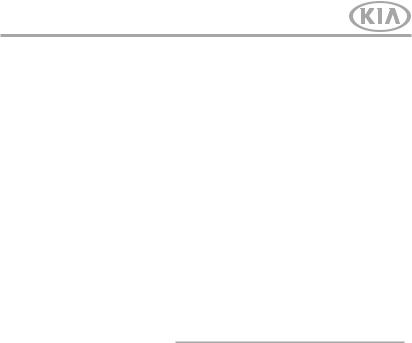
Kia, THE COMPANY
Thank you for becoming the owner of a new Kia vehicle.
As a global car manufacturer focused on building high-quality vehicles with exceptional value, Kia Motors is dedicated to providing you with a customer service experience that exceeds your expectations.
All information contained in this Owner’s Manual was accurate at the time of publication. However, Kia reserves the right to make changes at any time so that our policy of continual product improvement can be carried out.
This manual applies to all models of this vehicle and includes descriptions and explanations of optional as well as standard equipment. As a result, you may encounter material in this manual that is not applicable to your specific Kia vehicle.
Drive safely and enjoy your Kia! 
http://carownersmanuals2.com

F o r e w o r d
Thank you for choosing a Kia vehicle.
When you require service, remember that your Kia dealer knows your vehicle best. Your dealer has factory-trained technicians, recommended special tools and genuine Kia replacement parts. It is dedicated to your complete customer satisfaction.
Because subsequent owners require this important information as well, this publication should remain with the vehicle if it is sold.
This manual will familiarize you with operational, maintenance and safety information about your new vehicle. It is supplemented by a Warranty and Consumer Information manual that provides important information on all warranties regarding your vehicle.
We urge you to read these publications carefully and follow the recommendations to help assure enjoyable and safe operation of your new vehicle.
Kia offers a great variety of options, components and features for its various models. Therefore, some of the equipment described in this manual, along with the various illustrations, may not be applicable to your particular vehicle.
The information and specifications provided in this manual were accurate at the time of printing. Kia reserves the right to discontinue or change specifications or design at any time without notice and without incurring any obligation. If you have questions, always check with your Kia dealer.
We assure you of our continuing interest in your motoring pleasure and satisfaction in your Kia vehicle.
© 2017 Kia Canada Inc.
All rights reserved. Reproduction by any means, electronic or mechanical, including photocopying, recording, or by any information storage and retrieval system or translation in whole or part is not permitted without written authorization from Kia Canada Inc..
Printed in Korea
i

F o r e w o r d
HOW TO USE THIS MANUAL
We want to help you get the greatest possible driving pleasure from your vehicle. Your Owner’s Manual can assist you in many ways. We strongly recommend that you read the entire manual. In order to minimize the chance of death or injury, you must read the WARNING and CAUTION sections in the manual.
Illustrations complement the words in this manual to best explain how to enjoy your vehicle. By reading your manual, you will learn about features, important safety information, and driving tips under various road conditions.
The general layout of the manual is provided in the Table of Contents. Use the index when looking for a specific area or subject; it has an alphabetical listing of all information in your manual.
Sections: This manual has nine sections plus an index. Each section begins with a brief list of contents so you can tell at a glance if that section has the information you want.
You will find various WARNINGs, CAUTIONs, and NOTICEs in this manual. These WARNINGs were prepared to enhance your personal safety.You should carefully read and follow ALL procedures and recommendations provided in these WARNINGs, CAUTIONs and NOTICEs.
WARNING
A WARNING indicates a situation in which harm, serious bodily injury or death could result if the warning is ignored.
CAUTION
A CAUTION indicates a situation in which damage to your vehicle could result if the caution is ignored.
NOTICE
A NOTICE indicates interesting or helpful information is being provided.
ii
http://carownersmanuals2.com


|
|
|
Introduction |
|
1 |
|
|
|
|
|
|
|
|
|
Your vehicle at a glance |
|
2 |
|
|
|
|
|
|
|
|
|
|
|
|
|
|
|
Safety features of your vehicle |
|
3 |
|
|
|
|
|
|
|
|
|
|
|
|
|
|
|
Features of your vehicle |
|
4 |
|
|
|
|
|
|
|
|
|
|
|
|
table of contents |
|
|
Audio system |
|
5 |
|
|
|
|||
|
|
|
|
|
|
|
|
|
Driving your vehicle |
|
6 |
|
|
|
|
|
|
|
|
|
What to do in an emergency |
|
7 |
|
|
|
|
|
|
|
|
|
Maintenance |
|
8 |
|
|
|
|
|
|
|
|
|
|
|
|
|
|
|
Specifications & Consumer information |
|
9 |
|
|
|
|
|
|
|
|
|
Index |
|
I |
|
|
|
|
|
|
http://carownersmanuals2.com

Introduction
Fuel requirements . . . . . . . . . . . . . . . . . . . . . . . . . . |
1-2 |
1 |
• Gasoline containing alcohol and methanol. . . . . . . . . 1-2
• Do not use methanol . . . . . . . . . . . . . . . . . . . . . . . . . . . 1-4
• Fuel additives. . . . . . . . . . . . . . . . . . . . . . . . . . . . . . . . . 1-4
• Operation in foreign countries. . . . . . . . . . . . . . . . . . . 1-4
Vehicle break-in process . . . . . . . . . . . . . . . . . . . . . 1-5 HEV powertrain. . . . . . . . . . . . . . . . . . . . . . . . . . . . 1-5 Vehicle data collection and event data recorders. . 1-6
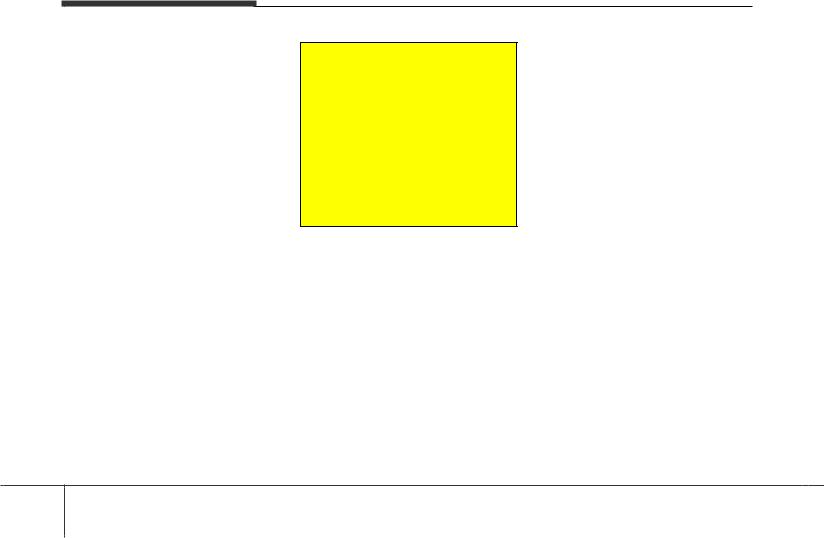
Introduction
FUEL REQUIREMENTS
Your new vehicle is designed to use only unleaded fuel having a pump octane number ((R+M)/2) of 87 (Research Octane Number 91) or higher. (Do not use methanol blended fuels.)
Your new vehicle is designed to obtain maximum performance with UNLEADED FUEL, as well as minimize exhaust emissions and spark plug fouling.
Never add any fuel system cleaning agents to the fuel tank other than what has been specified. (Consult an authorized Kia dealer for details.)
•Tighten the cap until it clicks one time, otherwise the Check Engine  light will illuminate.
light will illuminate.
WARNING - Refueling
•Do not "top off" after the nozzle automatically shuts off. Attempts to force more fuel into the tank can cause fuel overflow onto you and the ground causing a risk of fire.
•Always check that the fuel cap is installed securely to prevent fuel spillage, especially in the event of an accident.
Gasoline containing alcohol and methanol
Gasohol, a mixture of gasoline and ethanol (also known as grain alcohol), and gasoline or gasohol containing methanol (also known as wood alcohol) are being marketed along with or instead of leaded or unleaded gasoline.
Pursuant to EPA regulations, ethanol may be used in your vehicle.
Do not use gasohol containing more than 15% ethanol, and do not use gasoline or gasohol containing any methanol. Ethanol provides less energy than gasoline and it attracts water, and it is thus likely to reduce your fuel efficiency and could lower your MPG results.
Methanol may cause drivability problems and damage to the fuel system, engine control system and emission control system.
Discontinue using gasohol of any kind if drivability problems occur.
Vehicle damage or drivability problems may not be covered by the manufacturer’s warranty if they result from the use of:
1.Gasoline or gasohol containing methanol.
2.Leaded fuel or leaded gasohol.
3.Gasohol containing more than 15% ethanol.
1 |
2 |
http://carownersmanuals2.com |
|
|

Introduction
"E85" fuel is an alternative fuel comprised of 85 percent ethanol and 15 percent gasoline, and is manufactured exclusively for use in Flexible Fuel Vehicles. “E85” is not compatible with your vehicle. Use of “E85” may result in poor engine performance and damage to your vehicle's engine and fuel system. Kia recommends that customers do not use fuel with an ethanol content exceeding 15 percent.
NOTICE
Your New Vehicle Limited Warranty does not cover damage to the fuel system or any performance problems caused by the use of “E85” fuel.
NOTICE
Never use any fuel containing methanol. Discontinue use of any methanol containing product which may inhibit proper drivability.
Other fuels
Using fuels that contain Silicone (Si), MMT (Manganese, Mn), Ferrocene (Fe), and Other metalic additives, may cause vehicle and engine damage or cause misfiring, poor acceleration, engine stalling, catalyst melting, clogging, abnormal corrosion, life cycle reduction, etc.
Also, the Malfunction Indicator Lamp (MIL) may illuminate.
NOTICE
Damage to the fuel system or performance problem caused by the use of these fuels may not be covered by your New Vehicle Limited Warranty.
Use of MTBE
Kia recommends avoiding fuels containing MTBE (Methyl Tertiary Butyl Ether) over 15.0% vol. (Oxygen Content 2.7% weight) in your vehicle.
Fuel containing MTBE over 15.0% vol. (Oxygen Content 2.7% weight) may reduce vehicle performance and produce vapor lock or hard starting.
NOTICE
Your New Vehicle Limited Warranty may not cover damage to the fuel system and any performance problems that are caused by the use of fuels containing methanol or fuels containing MTBE (Methyl Tertiary Butyl Ether) over 15.0% vol. (Oxygen Content 2.7% weight.)
1 3

Introduction
Gasoline containing MMT
Some gasoline contains harmful man- ganese-based fuel additives Such as M M T ( M e t hy l c y c l o p e n t a d i e ny l Manganese Tricarbonyl). Kia does not recommend the use of gasoline containing MMT. This type of fuel can reduce vehicle performance and affect your emission control system. The Malfunction Indicator Lamp on the cluster may come on.
Do not use methanol
Fuels containing methanol (wood alcohol) should not be used in your vehicle. This type of fuel can reduce vehicle performance and damage components of the fuel system, engine control system and emission control system.
Fuel Additives
Kia recommends that you use good quality gasolines treated with detergent additives such as TOP TIER Detergent Gasoline, which help prevent deposit formation in the engine. These gasolines will help the engine run cleaner and enhance performance of the Emission Control System. For more information on TOP TIER Detergent Gasoline, please go to the website (www.toptiergas.com)
For customers who do not use TOP TIER Detergent Gasoline regularly, and have problems starting or the engine does not run smoothly, additives that can be purchased separately may be added to the gasoline.
If TOP TIER Detergent Gasoline is not available, one bottle of additive should be added to the fuel tank at every 12,000 km (7,500 miles) or every engine oil change is recommended. Additives are available from your authorized Kia dealer along with information on how to use them. Do not mix other additives.
Operation in foreign countries
If you are going to drive your vehicle in another country, be sure to:
•Observe all regulations regarding registration and insurance.
•Determine that acceptable fuel is available.
1 |
4 |
http://carownersmanuals2.com |
|
|

Introduction
VEHICLE BREAK-IN PROCESS
No special break-in period is needed. By following a few simple precautions for the first 1,000 km (600 miles) you may add to the performance, economy and life of your vehicle.
•Do not race the engine.
•While driving, keep your engine speed (rpm, or revolutions per minute) between 2,000 rpm and 4,000 rpm.
•Do not maintain a single speed for long periods of time, either fast or slow. Varying engine speed is needed to properly break-in the engine.
•Avoid hard stops, except in emergencies, to allow the brakes to seat properly.
•Don't tow a trailer during the first 2,000 km (1,200 miles) of operation.
HEV POWERTRAIN
By following a few simple precautions for the first 1,000 km (600 miles) you may add to the performance, economy and life of your vehicle.
•Do not race the engine.
•Avoid hard stops, except in emergencies, to allow the brakes to seat properly.
1 5

Introduction
VEHICLE DATA COLLECTION AND EVENT DATA RECORDERS
This vehicle is equipped with an event data recorder (EDR). The main purpose of an EDR is to record, in certain crash or near crash-like situations, such as an air bag deployment or hitting a road obstacle, data that will assist in understanding how a vehicle's systems performed. The EDR is designed to record data related to vehicle dynamics and safety systems for a short period of time, typically 30 seconds or less. The EDR in this vehicle is designed to record such data as:
•How various systems in your vehicle were operating;
•Whether or not the driver and passenger safety belts were buckled/ fastened;
•How far (if at all) the driver was depressing the accelerator and/or brake pedal; and,
•How fast the vehicle was traveling.
These data can help provide a better understanding of the circumstances in which crashes and injuries occur. NOTE: EDR data are recorded by your vehicle only if a non-trivial crash situation occurs; no data are recorded by the EDR under normal driving conditions and no personal data (e.g., name, gender, age, and crash location) are recorded. However, other parties, such as law enforcement, could combine the EDR data with the type of personally identifying data routinely acquired during a crash investigation.
To read data recorded by an EDR, special equipment is required, and access to the vehicle or the EDR is needed. In addition to the vehicle manufacturer, other parties, such as law enforcement, that have the special equipment, can read the information if they have access to the vehicle or the EDR.
1 |
6 |
http://carownersmanuals2.com |
|
|
